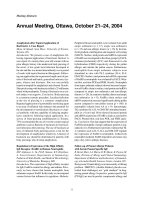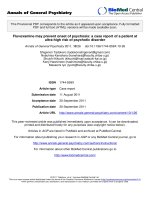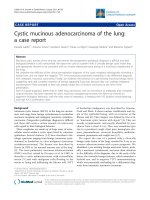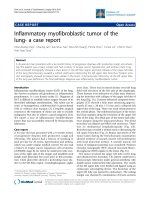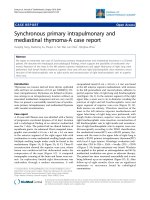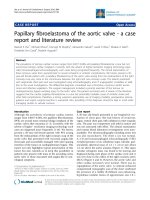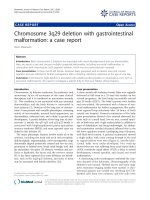Báo cáo y học: " Therapeutic approach to Gradenigo''''s syndrome: a case report." pptx
Bạn đang xem bản rút gọn của tài liệu. Xem và tải ngay bản đầy đủ của tài liệu tại đây (1.44 MB, 4 trang )
JOURNAL OF MEDICAL
CASE REPORTS
Kantas et al. Journal of Medical Case Reports 2010, 4:151
/>Open Access
CASE REPORT
BioMed Central
© 2010 Kantas et al; licensee BioMed Central Ltd. This is an Open Access article distributed under the terms of the Creative Commons
Attribution License ( which permits unrestricted use, distribution, and reproduction in
any medium, provided the original work is properly cited.
Case report
Therapeutic approach to Gradenigo's syndrome: a
case report
Ilias Kantas
1
, Anna Papadopoulou
1
, Dimitrios G Balatsouras*
2
, Andreas Aspris
3
and Nikolaos Marangos
1
Abstract
Introduction: Traditional management of Gradenigo's syndrome requires aggressive and radical surgery without any
attempt to preserve hearing. Recent reports, however, describe a successful outcome after conservative surgical
intervention without labyrinthectomy. A similar outcome has also been reported in patients who were only prescribed
with antibiotics and did not undergo myringotomy.
Case presentation: We report the case of a 24-year-old Caucasian Greek woman with Gradenigo's syndrome who was
treated by draining her petrous apex via an infralabyrithine approach between her posterior semicircular canal and the
jugular bulb. Her inner ear was not sacrificed during the procedure. She presented pre-operatively with ipsilateral
conductive hearing loss, which recovered completely four weeks after the surgery.
Conclusions: Patients with Gradenigo's syndrome may be successfully treated with a combination of long-term
permanent drainage and ventilation of the apical cells with corresponding hearing preservation. This can be achieved
via a combination of transmastoid, infralabyrinthine and suprajugular approaches, if such would be allowed by the
anatomy of the region or if there is enough space between the posterior semicircular canal and the jugular bulb.
Introduction
Apical petrositis was a common complication of acute
mastoiditis prior to the widespread use of antibiotics. It
reported occurred in 100,000 children with acute otitis
media [1]. In 1907, Gradenigo described a syndrome
characterized by a triad of symptoms related to apical
petrositis. These symptoms include otorrhea and hearing
loss, deep facial pain resulting from trigeminal involve-
ment and abducens nerve paralysis [2]. The trigeminal
ganglion and the sixth cranial nerve are separated from
the bony petrous apex only by the dura mater, hence their
vulnerability to inflammatory processes occurring within
this region [3]. The involvement of the sixth cranial nerve
is caused by the spread of inflammation through the
Dorello's canal under the petroclinoid ligament [3,4]. The
absence of abducens palsy, however, does not automati-
cally exclude apical petrositis from the findings [5].
Computed tomography (CT) and magnetic resonance
imaging are useful in the diagnosis and management of
Gradenigo's syndrome [6]. The interpretation of imaging
studies of the petrous apex, however, is complicated by
normal anatomical variation in the degree of pneumatiza-
tion in this region. Although 80% of the temporal bones
are pneumatized, air cells extending to the petrous apex
occur in only 30% of cases [3]. There are two main groups
of apical cells: those around the semicircular canals and
those around the cochlea [7]. The bony labyrinth forms a
natural barrier to the free drainage of mucus or pus from
these cells.
Although the disease has been typically managed with
aggressive surgical intervention, the advent of antibiotics
facilitated the conservative management of selected cases
[8] and it appears that the issue of optimal treatment of
the disease has yet to be settled. We report here the case
of our patient with apical petrositis presenting with the
typical Gradenigo's triad who was successfully treated via
an infralabyrithine approach with the preservation of
both her middle and the inner ear.
Case presentation
A 24-year-old Caucasian Greek woman was referred to us
by her general practitioner due to the presence of acute
abducens palsy a few hours prior to the referral. She had
been treated with cefaclor for five days prior to her pre-
sentation because she had severe left otalgia, hearing loss
* Correspondence:
2
Department of Otolaryngology, Tzanion General Hospital, Piraeus, Greece
Full list of author information is available at the end of the article
Kantas et al. Journal of Medical Case Reports 2010, 4:151
/>Page 2 of 4
and fever but no ear discharge. She was also found to
have a history of infection of the upper respiratory tract
one month ago. At the time of examination, she had
diplopia and a complete palsy of her left sixth cranial
nerve. She also complained of ipsilateral deep facial pain.
Otomicroscopy subsequently revealed an acutely infected
left ear with bulging tympanic membrane. A pure tone
audiometry demonstrated ipsilateral conductive hearing
loss (Figure 1A)
Gradenigo's syndrome was initially considered, and this
clinical diagnosis was confirmed by a high resolution CT
of her temporal bones (Figure 2) Since the CT scan dem-
onstrated that her jugular bulb was situated quite inferi-
orly under the labyrinth, our patient was scheduled for an
emergency transmastoid infralabyrinthine approach. The
aim of this approach was to preserve the cochleovestibu-
lar function.
A complete mastoidectomy involving the identification,
without the exposure of the sigmoid sinus, was per-
formed on our patient under general anesthesia. The
mastoid segment of the facial nerve and posterior semi-
circular canal of our patient were also identified. Drilling
was extended inferiorly and medially following the sig-
moid sinus in order to expose her jugular bulb. These
structures (mastoid segment of VII, posterior semicircu-
lar canal and jugular bulb) corresponded to the anterior,
superior and inferior margins, respectively, of the infral-
abyrinthine bony dissection.
Using a diamond burr, the infralabyrinthine air cell
tract was followed anteromedially between these three
structures, along the long axis of the temporal bone and
toward the petrous apex. This was occupied by purulent
secretions under pressure, which could be drained as
soon as the last bony septae was removed. The cavity was
irrigated copiously with hydrogen peroxide and normal
saline solution and inspected using an endoscope to
ensure a complete evacuation. A large-sized, 16Ch trans-
cutaneous silicone tube was left for two days to avoid
recurrence.
Cultures for aerobic and anaerobic bacteria obtained
from our patient showed the presence only of Streptococ-
cus pneumoniae, which was sensitive to cephalosporins.
After the operation, cefuroxime was administered intra-
venously for the initial two days and orally for the next
five days. The palsy of her sixth cranial nerve recovered
completely within 24 hours. A postoperative CT scan of
the temporal bones of our patient demonstrated the suc-
cessful infralabyrinthine path to the petrous apex (Figure
3 ).
Four weeks after the surgery, the hematotympanum
had completely resolved and the pre-operative conduc-
tive hearing loss was recovered (Figure 1B).
Discussion
Apical petrositis has been associated with severe and life-
threatening complications such as meningitis, brain
abscess, lateral sinus thrombosis, or even cavernal sinus
thrombosis, unless the area has been surgically decom-
pressed and drained. Many pioneer surgeons described
interventions with high morbidity and mortality and
without consideration for hearing preservation [9-11].
However, Frenckner [12] described an approach through
the superior semicircular canal. Eagleton [13], mean-
while, described a middle fossa approach, while Dearmin
[14] and Farrior [15] described an approach between the
posterior semicircular canal and the jugular bulb. All of
these latter approaches attempted to preserve hearing.
The use of proper antibiotic treatment dramatically
changed the incidence of the disease and its dramatic
course, but surgical drainage of the petrous apex was still
Figure 1 (A). Preoperative pure tone audiogram with conductive
hearing loss. (B) Recovery of air conduction four weeks postopera-
tively (dB: Decibels; kHz: kiloHertz).
Figure 2 Axial computed tomography scan demonstrating a flu-
id-filled mastoid cavity and a hole filled with soft tissue medially
to the cochlea. Notice the bone erosion of its walls.
Kantas et al. Journal of Medical Case Reports 2010, 4:151
/>Page 3 of 4
recommended. The management of petrous apex infec-
tion thus became more efficient. Functional preservation,
especially that of hearing, then became a possibility. In
more recent literature, satisfactory treatment results in
patients with Gradenigo's syndrome after the administra-
tion of high doses of broad-spectrum antibiotics that
penetrate the blood-cerebrospinal fluid barrier, as well as
less aggressive surgery, were reported [1].
In their review of literature, Minotti and Kountakis rec-
ommended treating patients with Gradenigo's syndrome
using intravenous antibiotics in conjunction with myrin-
gotomy and the insertion of large bore tympanostomy
tube, unless bone erosion was evident [16]. Al-Ammar
also reported a satisfactory outcome in the management
of patients with Gradenigo's syndrome under conserva-
tive treatment, but still had recurrent features of the syn-
drome after the extrusion of the ventilation tube [4].
We believe that the management of apical petrositis
should include permanent drainage and ventilation of the
apical cells while also attempting to preserve hearing.
This goal can be achieved through a transmastoid infral-
abyrinthine suprajugular approach, depending on the
anatomy of the region. This means there must be enough
space between the posterior semicircular canal and the
jugular bulb. Careful preoperative CT evaluation, includ-
ing coronal sections, is thus essential in ascertaining the
applicability of this procedure. This approach allows for
the exposure of all recesses that are obstructed by inflam-
matory lesions. It also facilitates the removal of debris,
purulent secretions, septae, granulation tissue, or fibrous
bands that hinder the drainage of the petrous apex. Com-
plete drainage can be achieved by the use of sterile endo-
scopes.
Strategies involving myringotomy and ventilation tubes
are less aggressive and may prevent the recurrence or
persistence of facial palsy, but the literature provides no
similar nor enough evidence pertaining to cases involving
abducens palsy. Yet another unanswered question is how
long the otologist should insist on conservative treatment
while avoiding the deterioration of the outcome of
abducens nerve palsy due to delayed surgery. It should be
noted, however, that more aggressive approaches that
tend to sacrifice hearing should not be totally excluded as
they might be necessary whenever recurrence and life-
threatening intracranial complications occur. A more
aggressive approach may also be considered in cases
involving pre-operative loss of conchleovestibular func-
tion and difficult anatomic configurations such as when a
high jugular bulb is present.
Conclusions
The petrous apex can be effectively drained in select
cases using an infralabyrithine approach between the
posterior semicircular canal and the jugular bulb, without
necessarily sacrificing the function of the inner ear.
Consent
Written informed consent was obtained from our patient
for publication of this case report and any accompanying
images. A copy of the written consent is available for
review by the Editor-in-Chief of this journal.
Competing interests
The authors declare that they have no competing interests.
Authors' contributions
IK examined and diagnosed our patient and participated in the design of the
study and in drafting the manuscript. AP examined and diagnosed our patient.
DB performed an audiological evaluation of our patient and helped in drafting
the manuscript. GG conceived the study and examined our patient. He also
reviewed the manuscript for important intellectual content. NM performed the
operation on our patient and critically reviewed the manuscript. All authors
read and approved the final manuscript.
Author Details
1
Centre of Otorhinolaryngology, Head and Neck and Skull Base Surgery,
Euroclinic Athens, Greece,
2
Department of Otolaryngology, Tzanion General
Hospital, Piraeus, Greece and
3
Nicosia General Hospital, Cyprus
References
1. Goldstein NA, Casselbrant ML, Bluestone CD, Kurs-Lasky M: Intratemporal
complications of acute otitis media in infants and children. Otolaryngol
Head Neck Surg 1998, 119:444-454.
2. Gradenigo G: Über die paralyse des nervus abducens bei otitis. Arch
Ohrenheileunde 1907, 774:149-187.
3. Gillanders DA: Gradenigo's syndrome revisited. J Otolayngol 1983,
12:169-174.
Received: 30 November 2008 Accepted: 24 May 2010
Published: 24 May 2010
This article is available from: 2010 Kantas et al; licensee BioMed Central Ltd. This is an Open Access article distributed under the terms of the Creative Commons Attribution License ( which permits unrestricted use, distribution, and reproduction in any medium, provided the original work is properly cited.Journal of Medical Case Repo rts 2010, 4:151
Figure 3 Postoperative computed tomography scan demonstrat-
ing the canal wall-up mastoidectomy and the path to the petrous
apex (arrows). VII indicates the mastoid portion of the facial nerve.
Kantas et al. Journal of Medical Case Reports 2010, 4:151
/>Page 4 of 4
4. Al-Ammar AY: Recurrent temporal petrositis. J Laryngol Otol 2001,
115:316-318.
5. Chole RA, Donald PJ: Petrous apicitis: Clinical considerations. Ann Otol
Rhinol Laryngol 1983, 92:544-551.
6. Murakami T, Tsubaki J, Tahara Y, Nagashima T: Gradenigo's syndrome: CT
and MRI findings. Pediatr Radiol 1996, 26:684-685.
7. Myerson MC: Suppuration of petrous pyramid. Arch Otolaryngol 1937,
26:42-48.
8. Burston B, Pretorius PM, Ramsden JD: Gradenigo's syndrome: successful
conservative treatment in adult and paediatric patients. J Laryngol Otol
2005, 119:325-329.
9. Lempert J: Complete apicectomy (mastoidotympanoapicectomy), new
technique for complete apical exenteration of apical carotid portion of
pertous pyramid. Arch Otolaryngol 1937, 25:144-177.
10. Kepetzky SJ, Almour R: Suppuration of petrous pyramid:
symptomatology, pathology and surgical treatment. Ann Otol Rhinol
Laryngol 1931, 40:396-414.
11. Ramadier J: Les ostéites profondes du rocher (Petrosite-Rochente). Bull
Loc Franc ORL 1933, 46:1-18.
12. Frenckner P: Some remarks on the treatment of apicitis (petrositis) with
and without Gradenigo's syndrome. Acta Otolaryngol (Stockh) 1932,
17:97-120.
13. Eagleton WP: Unlocking the petrous pyramid for localized bulbar
meningitis, secondary to suppuration of the petrous apex. Arch
Otolaryngol 1931, 13:386-398.
14. Dearmin RM: Logical surgical approach to tip cells of petrous pyramid.
Arch Otolaryngol 1937, 26:314-320.
15. Farrior JB: The sublabyrithine exenteration of the petrous apex. Ann
Otol Rhinol Larynol 1942, 51:1007-1015.
16. Minotti AM, Kountakis SE: Management of abducens palsy in patients
with petrositis. Ann Otol Rhinol Laryngol 1999, 108:897-902.
doi: 10.1186/1752-1947-4-151
Cite this article as: Kantas et al., Therapeutic approach to Gradenigo's syn-
drome: a case report Journal of Medical Case Reports 2010, 4:151
